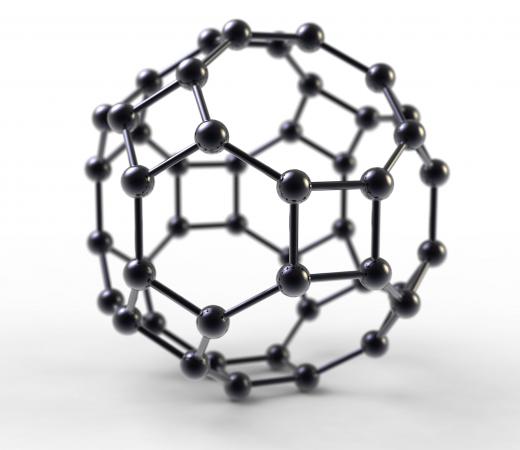What is a Buckyball?
 Michael Anissimov
Michael Anissimov
A buckyball is a spherical or ellipsoidal cage made up of covalently bonded carbon atoms. It is a fullerene, an allotrope (arrangement) of carbon, like graphite and diamond. C60 is the first fullerene discovered, and it is known as buckminsterfullerene, after architect Buckminster Fuller's geodesic domes, which the molecule resembles. Fullerenes are extremely strong but relatively expensive to produce and purify. Another variety of fullerenes are nanotubes, which are cylindrical rather than spherical.
Fullerenes were first discovered in 1985 by Harold Kroto, James Heath, Sean O'Brien, Robert Curl and Richard Smalley in molecular beam experiments. Later, they were observed in common places where carbon is found, such as candle soot. Kroto, Curl and Smalley were ultimately awarded the 1996 Nobel Prize in Chemistry for their work with these molecules.
Buckyballs come in all sizes. The smallest consists of 20 carbon atoms, and one of the largest has 540, though even larger variants are likely to be discovered or manufactured. The most frequently encountered ones have 60 or 70 carbon atoms.
Because these molecules form large cages, other atoms sometimes get trapped inside them. Evidence for an asteroid impact at the end of the Permian era was found by analyzing noble gases trapped in this way.

Fullerenes are the only allotrope of carbon that can be dissolved in liquids, and even then, only in small quantities. A solution of pure fullerene is purple in color. Although there have been questions about the safety of the buckyball to marine animals, it is known that they are largely inert and the evidence against their reactivity is much higher than that in favor of it.
Metallofullerenes combine together metallic ions with carbon atoms, and other variants are also possible. Research in this area is just beginning.

The most common production method for these molecules is to situate a block of graphite between two electrodes and send a charge through the block. The resulting plasma arc causes the creation of many fullerenes, which must then be isolated from the surrounding soot.
AS FEATURED ON:
AS FEATURED ON:













Discussion Comments
1.) No
2.)Yes
Don't ask...
I am writing a novel and want to check if what I propose will work.
1)Are carbon fiber objects detectable by security scans?
2)Will security scans penetrate carbon fiber containers to show the contents?
Post your comments